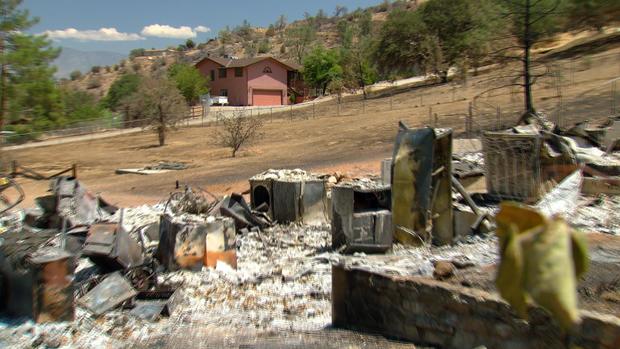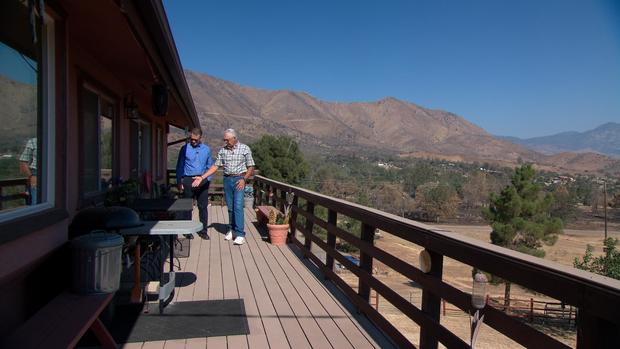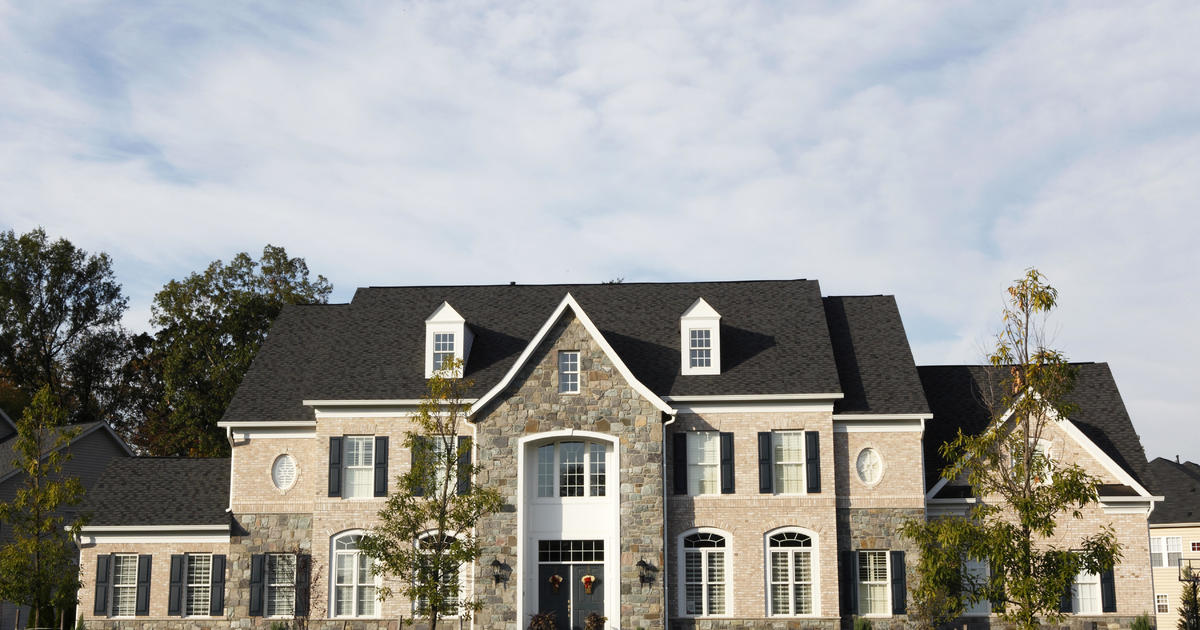Why fighting wildfires often fails -- and what to do about it
Fighting wildfires in America cost federal agencies almost $2 billion last year including more than half the budget of the U.S. Forest Service. Wildland fires are growing worse in a time of drought and climate change, and the biggest and most destructive fires can't be stopped. They are a force of nature: imagine trying to stop a hurricane. Yet the government has to try, because more than a 100 million Americans now live in -- or near -- forests and grasslands that can erupt in flames.
This is what's left of a neighborhood in the Kern River Valley. It's outside Bakersfield, California. Much of the valley burned in a wildfire that swept across 75 square miles. It killed two people and destroyed 285 homes. The wildlands that fed this fire are the same wildlands that attracted residents like Fred Roach.
Steve Inskeep: Is this the view that brings people to live in this spot?
Fred Roach: It's the view that brought us here. Yes, sir.
Roach lives amid mountains covered with grass so dry that lightning strikes or human activity can easily set it on fire. He used to be a firefighter and saw smoke rise over the valley on June 23rd.
"I never expected this fire to do what it did. This is going to go down as one of the fastest spreading wildland fires in California's history."
Fred Roach: The wind was blowing 20, 30 miles an hour and it came right at us.
The fire moved miles in a matter of minutes, faster than fire crews, under Chief Brian Marshall, could keep up.
Brian Marshall: I never expected this fire to do what it did. This is going to go down as one of the fastest spreading wildland fires in California's history.
Steve Inskeep: Why did it spread so quickly?
Brian Marshall: Wind. Wind, coupled with drought. Hot, dry conditions on a summer day in the Kern River Valley, and all we needed was a spark and there was no stopping that fire.
It kept burning despite the efforts of firefighters who spent $22 million trying to stop it.
Steve Inskeep: Is there something the public doesn't get about the really big, fast-moving, dangerous fires?
Brian Marshall: When you have the extreme fire behavior, when the weather, fuel, and topography sets up there may not be anything that we can do.
More houses than ever lie within the reach of such fires. There are now 43 million homes in or near wildlands. They're in every part of the country. Neighborhoods amid forests and grasslands are now so common, they have their own special name. It's called the "wildland urban interface" where people can live close to nature and to the fires that burn there.
Brian Marshall: These homes are part of the urban interface. This entire community here is the urban interface. And we are fighting wild land fires in the middle of these neighborhoods.
As more houses are built near wildlands, more of them burn. Fifty years ago, wildfires destroyed a few hundred structures per year across the United States. Now it's more than 3,000. Last November, wind-driven wildfires near Gatlinburg, Tennessee, killed 14 people and damaged or destroyed more than 2,400 homes and businesses. In Northern California, the year before, this fire burned more than a thousand homes, helping to make 2015 the most destructive and costly year of wildfires in U.S. history.
Chopper pilot: This is a lot of homes here and they're really close to this fire.
Of the tens of thousands of wildfires that break out each year. Only a few get this bad. But they're the ones that burn the most land, destroy the most homes, and cost the most in often futile efforts to fight them.
Robert Bonnie: Fire has always been part of the landscape. It will always be part of the landscape.
Robert Bonnie was under secretary for Natural Resources and Environment at the U.S. Department of Agriculture during the Obama administration. For three-and-a-half years, he oversaw the Forest Service – the country's largest firefighting agency.
Vintage Forest Service Film
Voiceover: Over 1,000 engine strike teams were summoned to protect life and property from an inferno.
For decades, Forest Service crews tried to put out every fire by the next morning. It was a heroic undertaking, with a side effect. They were stamping out fires that would normally have cleared out deadwood and undergrowth. Instead that fuel built up over time, setting the stage for bigger fires.
Robert Bonnie: Fires in a lot of those forests are burning differently than they did before. There are really two reasons for that. One is climate change. We're seeing weather patterns and extreme weather events, drought and other things that are causing those fires to burn differently. And the second reason is that because for so long we preached fire suppression and putting out those small fires, we've built up fuel loads. And so our fires are burning hotter. They're burning bigger. They're more catastrophic.
And the fire season, which once lasted a few months, now lasts almost all year. As the fires grew worse, more people were moving in. Since 1990, 60 percent of all the homes in the United States have been built in the wildland urban interface, where the beauty comes with risks. In 2012, a wildfire swept out of the Rockies and into these neighborhoods on the edge of Colorado Springs, destroying 347 homes.
Robert Bonnie: The challenge is we've got houses in places we didn't used to have houses. And that puts people and property at risk. And so we're having to fight fire in a different way than we did before.
Steve Inskeep: Tell me about the wildland urban interface. Who's in control of it?
Robert Bonnie: The federal government isn't in the business of land use. That's really done at the local county or municipal level. And the decisions that are made there have huge consequences for the American taxpayer, because we will spend more money, and today are spending more money firefighting, because of where those houses are on the landscape.
Steve Inskeep: Private property owner buys land, gets permission from the county or whoever to build a house, and the federal government ends up getting the bill to try to protect that house?
Robert Bonnie: There's no question that we're spending more on the federal-government side firefighting today because of houses in the landscape that we had nothing to do with approving.
Over the last 20 years, all federal agencies together have spent $25 billion to put out fires. Bonnie would rather spend some of that money thinning out forests before they burn.
Robert Bonnie: We're not investing as much as we can and should in forest restoration, because we're having to spend all our money fighting fire.
Steve Inskeep: Wait a minute, forest restoration is prevention of horrible wildfires?
Robert Bonnie: That's right.
Steve Inskeep: Are you taking money away from prevention?
Robert Bonnie: Absolutely.
Robert Bonnie: The other issue is we put firefighters' lives in danger if we ask them to fight fires that essentially we can't stop.
Radio: It's real dicey in the subdivision, kinda use your judgement…
Since 1990, a total of 468 firefighters have died in the wildlands including these men. They were elite firefighters known as the Granite Mountain Hotshots. In 2013, they deployed to fight this fire outside Yarnell, Arizona. Time lapse video shows how the wind shifted the fire in a dangerous new direction. The 19 men were trapped, and killed. In the town they died trying to protect, no residents were hurt, but 129 buildings burned.
Events like this add urgency to the work at a U.S. Forest Service lab. In this building in Missoula, Montana, scientists study how fires spread.
And one of them, Jack Cohen, made a specialty of how to better defend homes.
Jack Cohen: Clearly we're not gonna solve the problem by telling people they're gonna have to move their houses into a city from being out in the woods.
Steve Inskeep: Not gonna happen.
Jack Cohen: Right? It's not gonna happen for a whole bunch of reasons, one of which is that the population who live there, including me-- aren't gonna do it.
Steve Inskeep: Is it reasonable for a homeowner in that situation, a fire bearing down on their neighborhood to just say, "Look, I pay my taxes. There are firefighters, there's a fire department. The forest service, if it's public land, has thousands of firefighters. It's their job; put it out?"
Jack Cohen: So what if they can't? Then the question becomes one of, "Well, if the extreme wildfires are inevitable does that mean that wildland-urban fire disasters are inevitable?" And my answer to that is no.
Jackson Training Session
Cohen: At no point did anybody identify how homes ignited.
Cohen realized if he understood the way houses catch fire, he could figure out how to protect them.
USDA VIDEO: Protecting Your Home From Wildfire
Cohen: What ignited this house and burned it down were the little things.
The little things. Cohen learned that a wildfire throws up a blizzard of embers that wind can drive up to a mile. The embers, also known as firebrands, start new fires, if they land on something flammable. Like wooden shingles. Wooden decks. Firewood against a wall. Pine needles in a gutter.
Jack Cohen: And most frequently the things that it's igniting is debris around the structure. It's the stuff that's there primarily because we live there.
Jack Cohen says he knows these are danger spots because he ran simulations with life-sized homes in a lab.
Jack Cohen: We have firebrand generators, and you can watch millions of these brands then begin to collect wherever they land. If the base of the house has flammable material we end up with fire. We see the gutters igniting and putting flame right up against the eave line. What if we don't have anything that can support fire within five feet of the structure? What if we don't have pine needles in the gutters, right? Then the firebrands, it doesn't matter from how far they come, don't ignite anything.
Steve Inskeep: Just clean the gutters?
Jack Cohen: Clean the gutters. Clean the debris off your deck.
Last summer's fast-moving fire in Kern County, California, became a real-world demonstration of Jack Cohen's research. Kern County requires property owners to clear 100 feet of defensible space around homes. You can tell the ones who probably did, and the ones who likely didn't. One week before the fire, an inspection found that one house looked like this. A week later, the house looked like this. Fire Chief Brian Marshall says he didn't have enough fire engines in the county to protect every vulnerable home.
Brian Marshall: Maybe a hundred foot of defensible space isn't enough for this house. But it didn't have any.
If you were just driving through Kern County, you might think it's completely random that this house burned, and this one didn't. The owner says it's not. It's the house of Fred Roach, that retired Forest Service firefighter.
Fred Roach: This house right here was prepared and did not need the air tanker full of retardant or the helicopter full of water or all the engines to protect it. It-- it was-- it protects itself.
Fred Roach thought about fire when improving his home, and says anyone can do what he did.
Fred Roach: The house was stucco'ed about fire years ago. And we stucco'ed everything under the eaves, the entire thing.
Steve Inskeep: Stucco's basically fireproof—
Fred Roach: Basically, yeah.
Steve Inskeep: --close to it?
Fred Roach: Close to it. And then, we took all the redwood decking off the deck..
Fred Roach:...and replaced it with synthetic.
Steve Inskeep: Which doesn't burn nearly as—
Fred Roach: No. No.
Steve Inskeep: --easily?
Fred Roach: We had embers all over this deck and nothing happened.
Steve Inskeep: So, now that you're retired, do you still find yourself mentally triaging houses as you drive past them? "That one's defensible. That one is hopeless."
Fred Roach: Of course, I do. Yeah. We discuss it all the time, my wife and I, you know. "I sure wish that they'd do this," or, "I sure wish that they'd do that." There's nothin' we can do about it.
Which is frustrating to Judy Hyatt. She's president of the Kern River Valley Fire Safe Council. It urges homeowners to make their homes less flammable. Many people tell her they don't have time.
Steve Inskeep: When people have not properly prepared their homes, what do they expect from the fire department when—
Judy Hyatt: They expect them—
Steve Inskeep: --fire approaches?
Judy Hyatt: --to be there, particularly the aircraft. And most of the time they are. Maybe this fire will cause people to have second thoughts because this time they couldn't be there and couldn't keep up with what was going on when they did get there.
Steve Inskeep: Do you think that most homes could be built and maintained in such a way that when a fire approaches, people could just evacuate, wait for the fire to pass—
Judy Hyatt: I do.
Steve Inskeep: --and otherwise ignore it?
Judy Hyatt: I do.
Steve Inskeep: Meaning we could do a lot less to fight fires and just be prepared—
Judy Hyatt: Yeah—
Steve Inskeep: --better—
Judy Hyatt: --you have to--
Steve Inskeep: --at the beginning.
Judy Hyatt: --be prepared better before you do less. Because right now, we're not. We really aren't.
Produced by David Schneider and Joyce Gesundheit.






